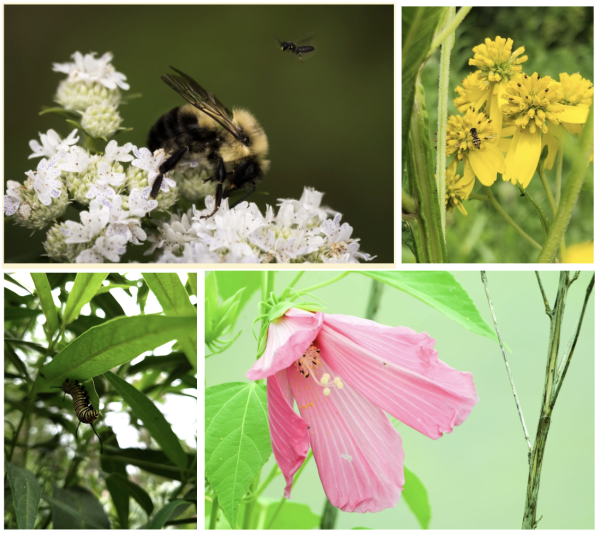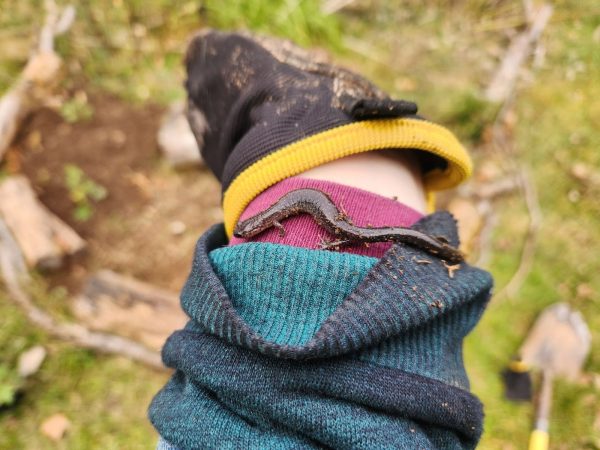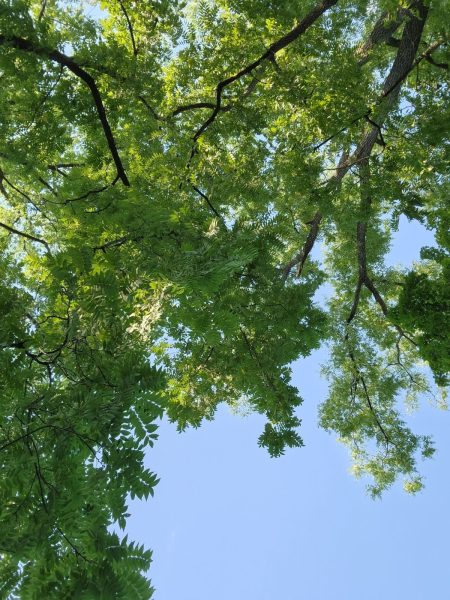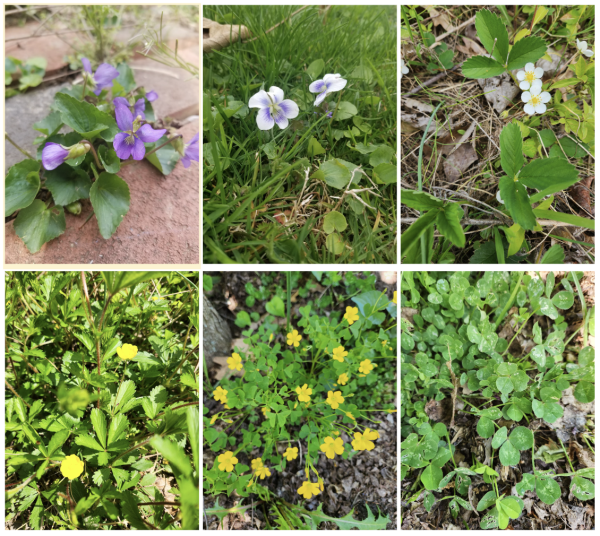Right now, if you look out the nearest window, I bet you can see a lawn. Or at the very least, you can walk a short distance to find one. As of 2005, NASA Earth Observatory estimated that the US has about 31.6 million acres of lawn across the country’s vastly different climate and soil conditions. That’s more surface area than cornfields in our country. That number has likely only grown in the years since then. Lawns are one of the most ubiquitous landscape design features in the US today, but should they be? A growing number of homeowners, and even businesses, are getting tired of that hyper-manicured, wildlife-deficient look and turning towards a more ecologically-minded landscaping style.
A History Note For Context
Our modern lawns were first developed in England over the course of 3 centuries from the 1500s to the 1700s – the “English Garden” is composed of large expanses of lawn dotted with grand specimen trees allowed to grow in their natural shape, garden beds designed to flow with the terrain, and Renaissance-style architectural and sculptural elements. This gardening style was largely a rejection of the complicated geometrical style of the French gardens like those of Versaille, in favor of a more ‘natural’ look partially inspired by Chinese gardens. The overall goal, as with the styles that the English Garden is influenced by, is to display wealth. The ability to use grassland for lawn rather than pasture was a luxury. Beyond the size and grandeur of the land, this display of wealth was also articulated by the variety, “exotic-ness,” and rarity of the plants growing there.
The newly-established travel and trade across the Atlantic Ocean introduced both new plant species and new ideas of horticulture and land management to each side of the ocean. Early promoters of the English Garden style and philosophy in North America were the elites of the British colonies like George Washington, Thomas Jefferson, James Madison, Ben Franklin, and Philadelphia’s first mayor, James Logan. Here in Pennsylvania, the power to decide how land should be managed and cultivated was forcibly taken by colonists like William Penn’s sons from the Lenape, the very people who have the most cultural investment in our region’s native plants. The English Garden aesthetic spread westward across the continent alongside the expansion of the US’s colonial power.
Over time, the standard set by these affluent and influential men became more and more accessible to those with less wealth. The invention of the push lawn mower in 1870 reduced the amount of labor needed to maintain a lawn. New varieties of grasses were developed and tested for different regions of the country by the USDA and US Golf Association in the early 1900s. The 1950s and suburbanization is probably the time and place that people most associate with lawns, as the new middle class of post-World War II America adopted the aesthetics of the wealth to which they aspired.
The Downside to Ubiquitous Lawns
Lawns do one thing very well and lots of things very poorly. Turf grass is very good at withstanding a great deal of foot traffic while still looking lush and neat, especially when given full sun, lots of water, and supplements of fertilizers and weed killers. Turf grass is not good at feeding or sheltering wildlife, building healthy soils, storing carbon, or absorbing rainwater. If I’m being generous, I might give lawns credit for reducing erosion during heavy storms by causing rain to run right off the surface of the grass while the roots hold the soil; however, since most of that water is running off the surface and not being absorbed into the ground, all that rainwater will cause erosion elsewhere or get funneled into sewers, rather than percolate down into our groundwater supply. All this is to say, lawns have lots of aesthetic value to our culture, but very little ecological value, so maybe it’s time to shift our backyards’ lawn-to-native-plants ratios.
A little lawn goes a long way. In your yard or maybe at your place of work, which parts of the lawn do people actually walk over, play or congregate on, or make use of? You’ll likely notice that people tend to follow practical paths across the lawn to get to a shed or bench or some other structure, while at other times they take meandering paths to enjoy the scenery. Perhaps there is an area or two where kids tend to play. I would argue that the only lawn you need is along those paths and around those features where play and relaxation happen.
What Is a Habitat?
The definition of habitat is the natural home or environment of an animal, plant, or other organism. When I set the goal of “creating habitat,” what I mean is “establish the native plants that form the base of the food web needed to support a range of wildlife.” I specify native plants, because they almost always feed a greater number of species than their non-native counterparts, the result of thousands to millions of years of evolutionary relationship building. You can certainly tailor your exact plant selection to attract specific animals, or you can work with the native plants that strike your fancy and fit the physical conditions of your project area, then wait to see who shows up to live there.

Many popular habitat-creating projects are aimed at pollinators, and you may want to take that approach as well. This emphasis is born out of the essential links in the food web that this group of animals creates. There are thousands of pollinating insects native to our region, from our 438 species of bees to almost the entire lepidoptera order (that’s moths and butterflies), to hover flies whose bodies mimic the look of bees to avoid predation, to a few beetles. Plus, who can forget the charismatic ruby-throated hummingbird who seeks out the nectar of red, tubular flowers? The flowers a pollinator successfully pollinates eventually develop into fruits, nuts and seeds which in turn feed birds, mammals, some turtles and other wildlife. In the process, all of these pollinators turn pollen and nectar into calories and building blocks for their own bodies which then feed larger creatures who wouldn’t be able to do anything with a flower.
To put the philosophy of gardening for habitat most simply: a diversity of native flora at the foundation of the food web leads to a diversity of herbivores and pollinators, which lead to a diversity of omnivores and carnivores, all of whom eventually feed a diversity of detritivores.
Making a Change
The very first step in a lawn-to-habitat conversion project is setting your goals and making a plan. What type of wildlife are you most interested in? What kind of habitat is needed to support that wildlife? Or working in the opposite direction, what type of habitat do you like to be around? What flora and fauna contribute to that desired environment? There is essentially one big choice to be made early in the project: are you going for a meadow, a forest, or some combination of the two? Once you’ve come up with an initial vision, consider the physical limitations of your land, such as the amount of light and water distributed across the project area and the soil quality. Work within those physical constraints for the best (and easiest) results.
The second step to a lawn-to-habitat conversion project is removing the lawn, which people do in a variety of ways from covering a large area with cardboard or a tarp until the existing grass dies, to digging it out with a shovel, using a sod-cutter or a plow, to limited and strategic herbicide use. Always follow the label’s instructions closely when using herbicides. Consult with your county’s Conservation District about erosion control if you are disturbing a large area or are working near a waterway or wetland. Once the grass has been removed and/or killed, it’s best to get the seeds or plants in the ground right away and then cover up the rest of the exposed soil with a mulch to prevent invasive species and other weeds.

For sources of native plants, DCNR maintains an extensive list of native plant nurseries. Many nature centers like Peace Valley Nature Center, Churchville Nature Center, Pennypack Environmental Center, and Schuylkill Center for Environmental Education also have a native plant sales in the spring and early summer, while the Penn State Extension Master Watershed Stewards do a native tree and shrub sale in the early fall. Spring and fall tend to be the best seasons to plant.
You may be able to find plants advertised as native at other more conventional nurseries like Agway and Lowes, but these labels aren’t always reliable (to check, look up the species by its scientific name in BONAP’s North American Plant Atlas). I highly recommend looking for the wild type of our native plants whenever possible. To gauge how selective you should be about your seed/plant sources, consider whether your project is large and well-connected to other populations of the same species, in which case you want to find the wild type from a local source, or your project is smaller and located in a highly-disrupted and isolated area in which case you can still get a lot of value from some nativars. To learn more about which nativars have decent ecological value check out Mt. Cuba Center’s Trial Gardens research.

When selecting plants, getting a variety and trying to ensure there will always be something in bloom throughout the growing season are good goals for building biodiversity and supporting pollinators. In some cases, there may already be native plants in your backyard, which can provide a great starting point by telling you about the growing conditions. Apps like iNaturalist, or its slightly more user-friendly but less collaborative counterpart Seek, are great tools for identifying plants.

As for mulches, leaf litter is best in my experience. You can purchase it in the form of leaf mulch or leaf compost, and it may be offered for free if your borough or township does leaf collection. Applying leaf litter and letting it accumulate each fall builds nutrients in the soil, creates nesting and hibernation sites for insects like native bees and fireflies, while also suppressing weeds. Non-dyed wood mulches or straw mulches can be effective too, if done right. A better way to incorporate woody material in your garden is finding places for some logs and branches to lay and decompose naturally. These logs and branches provide valuable habitat for the insects, fungi, salamanders, and other small creatures that will in turn attract birds and other wildlife to your backyard. Once established, meadows can go without mulching in the traditional sense because they grow so densely and then die back and get mowed down each winter.
Weeding in this context should really focus on invasive species, and in the case of a meadow project, stopping trees from establishing themselves. Using the aforementioned iNaturalist and/or Seek apps to help you figure out which volunteer plants are invasive and which are native plants is very important. If given the opportunity, invasive species will take full advantage of the available growing space and disturbed soil to overrun your project. Once you’ve figured out which invasive species are popping up, you can check out resources like the DCNR and Penn State Extension websites to learn more about managing them.
Responsible Lawn Patches
In places where the lawn remains, best practices for wildlife include not applying pesticides and fertilizers, and mowing high to allow flowering “weeds” like clovers, wood sorrel, common violets, wild strawberry, green-and-gold, etc. to live in the lawn.

Finally, consider opportunities to limit light and noise pollution which are disturbances that often go overlooked, but which still have profound impacts on wildlife. Perhaps try to run fewer motors by lengthening the time interval at which you mow or opting to sweep your driveway and walkways rather than using a leaf-blower. Maybe reduce the number of light fixtures or replace existing lights with amber LEDs to cut back on your UV/white/blue-spectrum light emissions at night.
Getting More Help
This is a lot of info, but a lawn conversion project like this really is doable, especially if you are okay with doing it gradually and with some trial and error. If you want more info to help you plan out your lawn-to-habitat project, here is a list of further reading and resources:
- PA DCNR provides some advice about planting with natives in addition to their nursery list. They also have a list of invasive plant species that can help you identify species to target for removal.
- The Penn State Extension Master Gardeners are another great source of information.
- Bowman’s Hill Wildflower Preserve has online guides to picking the right plant for the right place, and in-person knowledgeable volunteers at their Native Plant Nursery.
- There are a number of different organizations that will certify your garden as habitat once you meet a checklist of requirements which can be a helpful framework to design around. These initiatives include the National Resource Defense Council’s Wildlife Habitat certification and Monarch Watch’s Monarch Waystation certification. You can also join Homegrown National Park, the Two Thirds for the Birds movement and take the Xerces Society’s “Bring Back Pollinators” pledge to join a broader community.
- Check out Doug Tallamy’s books Nature’s Best Hope, The Nature of Oaks and/or his landscape design book The Living Landscapes.
- Check out Catherine Zimmerman’s book Urban & Suburban Meadows, Bringing Meadowscaping to Big and Small Spaces.
Final Thoughts
With all of these considerations in mind, thank you for taking the time to see the ecological potential of your lawn spaces. I hope that this walk through the lawn-to-habitat conversion process has been a helpful catalyst for the changes you want to make to your outdoor spaces. Let’s break from tired traditions and grow a more fulfilling future for both us and our non-human neighbors.
Thank you for reading.
Katie Toner, Conservation Easement Steward
